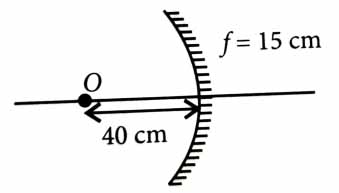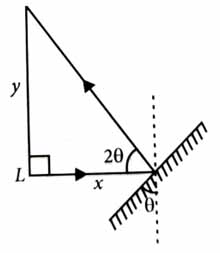Topic Question Set
Q 1
:
Given below are two statements:
Statement I: Image formation needs regular reflection and/or refraction.
Statement II: The variety in colour of objects we see around us is due to the constituent colours of the light incident on them.
In the light of the above statements, choose the most appropriate answer from the options given below: [2024]
Statement II: The variety in colour of objects we see around us is due to the constituent colours of the light incident on them.
Statement I is correct but Statement II is incorrect.
Statement I is incorrect but Statement II is correct.
Both Statement I and Statement II are correct.
Both Statement I and Statement II are incorrect.
(1)
Regular reflection is necessary for image formation, that is why we can see our image in a mirror but not on a wall. So, statement-I is correct. Different colours in white light as its constituents are responsible for variety in colour of objects.
Q 2
:
An object is placed at a distance of 40 cm from a concave mirror of focal length 15 cm. If the object is displaced through a distance of 20 cm towards the mirror, the displacement of the image will be [2018]
30 cm away from the mirror
36 cm away from the mirror
30 cm towards the mirror
36 cm towards the mirror
(2)

Using mirror formula,
When object is displaced by 20 cm towards mirror.
Now,
So, the image will be shift away from mirror by (60 - 24) cm = 36 cm.
Q 3
:
A beam of light from a source L is incident normally on a plane mirror fixed at a certain distance from the source. The beam is reflected back as a spot on a scale placed just above the source L. When the mirror is rotated through a small angle , the spot of the light is found to move through a distance y on the scale. The angle is given by [2017]
(4)

When mirror is rotated by angle, reflected ray will be rotated by .
For small angle
Q 4
:
Match the corresponding entries of Column 1 with Column 2. [Where is the magnification produced by the mirror] [2016]
Column 1
Column 2
(A)
m = –2
(p)
Convex mirror
(B)
(q)
Concave mirror
(C)
m = +2
(r)
Real image
(D)
(s)
Virtual image
A → p and s; B → q and r; C → q and s; D → q and r
A → r and s; B → q and s; C → q and r; D → p and s
A → q and r; B → q and r; C → q and s; D → p and s
A → p and r; B → p and s; C → p and q; D → r and s
(3)
Magnification in the mirror,
As and have same signs so the mirror is concave and the image formed is real.
As and have different signs but magnification is 2 so the mirror is concave and the image formed is virtual.
As and have different signs with magnification , so the mirror is convex and the image formed is virtual.

